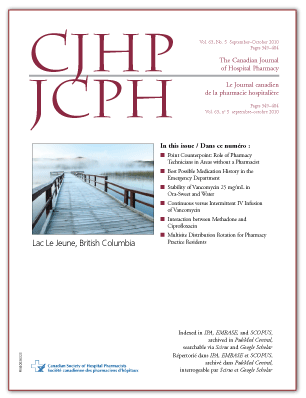Best Possible Medication History in the Emergency Department: Comparing Pharmacy Technicians and Pharmacists
DOI:
https://doi.org/10.4212/cjhp.v63i5.947Keywords:
medication reconciliation, pharmacy technician, best possible medication history, BPMH, emergency department, bilan comparatif des médicaments, technicien en pharmacie, meilleur schéma thérapeutique possible, MSTP, service des urgencesAbstract
ABSTRACT
Background: Obtaining an accurate and complete medication list (i.e., the best possible medication history [BPMH]) is the first step in completing medication reconciliation. The ability of pharmacy technicians to obtain medication histories, relative to that of pharmacists, has not been formally assessed.
Objectives: To determine whether pharmacy technicians at the authors' institution could obtain a BPMH as accurately and completely as pharmacists and if both groups met national norms for unintentional discrepancies and the success index for medication reconciliation.
Methods: Pharmacy technicians were trained in obtaining a BPMH at the beginning of the study, before any patients were enrolled. Patients presenting to the emergency department were prospectively enrolled to be interviewed separately by both a pharmacist and a technician, with information recorded on standard medication reconciliation forms. The completed forms for each patient were compared following each set of interviews, and discrepancies were clarified with the patient.
Results: Fifty-nine patients were included in the study, and 3 pharmacists and 2 technicians obtained the histories. There was no significant difference between pharmacists and technicians in terms of discrepancies involving prescription drugs (χ2 = 0.52, df = 1, n = 118, p = 0.47, Cramer's V for effect size = 0.07) or over-the-counter medications (χ2 = 0.09, df = 1, n = 118, p = 0.77, Cramer's V = 0.03). The mean number of discrepancies per patient did not differ significantly between the pharmacists and technicians (t = 0.15, df = 58, p = 0.88 for prescription drugs; t = -0.22, df = 58, p = 0.83 for over-the-counter products). For both groups, the number of unintentional discrepancies per patient was significantly lower and the success index for medication reconciliation significantly higher than the national average.
Conclusions: Trained pharmacy technicians at the authors' institution were able to obtain a BPMH with as much accuracy and completeness as pharmacists. Both groups were significantly superior to the national average in terms of unintentional discrepancies and success index for medication reconciliation.
RÉSUMÉ
Contexte : L'obtention d'une liste précise et complète des medicaments (c.-à-d. le meilleur schéma thérapeutique possible [MSTP]) est la première étape du bilan comparatif des médicaments. La capacité des techniciens en pharmacie, comparativement à celle des pharmaciens, d'obtenir les histoires médicamenteuses n'a pas été évaluée officiellement.
Objectifs : Déterminer si les techniciens en pharmacie dans l'établissement des auteurs pouvaient obtenir un MSTP aussi précis et complet que les pharmaciens et si les deux groupes satisfaisaient aux normes nationals pour ce qui est des divergences non intentionnelles et de l'indice de réussite pour ce qui est du bilan comparatif des médicaments.
Méthodes : Les techniciens en pharmacie ont été formés sur la technique d'obtention du MSTP au début de l'étude, avant l'inscription des patients. Les patients qui consultaient au service des urgences ont été inscrits de façon prospective pour être interviewés séparément par un pharmacien et par un technicien, et l'information était consignee sur des formulaires standard de bilan comparatif des médicaments. Les formulaires remplis pour chaque patient ont été comparés à la suite de chaque série d'entrevues, et les divergences ont été clarifiées avec les patients.
Résultats : Un total de 59 patients ont été inscrits à l'étude. Trois pharmaciens et deux techniciens ont obtenu les histoires médicamenteuses. Aucune différence significative n'a été observée entre les pharmaciens et les techniciens pour ce qui est des divergences au chapitre des medicaments d'ordonnance χ2 = 0,52, df = 1, n = 118, p = 0,47, V de Cramer pour l'ampleur de l'effet = 0,07) ou des médicaments en vente libre (χ2 = 0,09, df = 1, n = 118, p = 0,77, V de Cramer = 0,03). Aucune difference significative n'a été observée quant au nombre moyen de divergences par patient entre les pharmaciens et les techniciens (t = 0,15, df = 58, p = 0,88 pour les médicaments d'ordonnance; t = - 0,22, df = 58, p = 0,83 pour les produits en vente libre). Le nombre de divergences non intentionnelles par patient pour les deux groupes était significativement plus bas et l'indice de réussite pour ce qui est du bilan comparatif des medicaments était significativement plus élevé que les moyennes nationales.
Conclusions : Les techniciens en pharmacie qualifiés dans l'établissement des auteurs ont pu obtenir un MSTP aussi précis et complet que celui des pharmaciens. Les deux groupes ont eu des résultats significativement supérieurs à ceux de la moyenne nationale quant aux divergences non intentionnelles et à l'indice de réussite pour ce qui est du bilan comparative des médicaments.
Downloads
Downloads
Issue
Section
License
Copyright © Canadian Society of Healthcare-Systems Pharmacy.
After publication of a manuscript in the CJHP, the authors of the manuscript must obtain written permission from the CSHP (publications@cshp.ca) before reproducing any text, figures, tables, or illustrations from the work in future works of their own. If a submitted manuscript is declined for publication in the CJHP, all said rights shall revert to the authors. Please note that any forms (e.g., preprinted orders and patient intake forms) used by a specific hospital or other health care facility and included as illustrative material with a manuscript are exempt from this copyright transfer. The CJHP will require a letter from the hospital or health care facility granting permission to publish the document(s).










